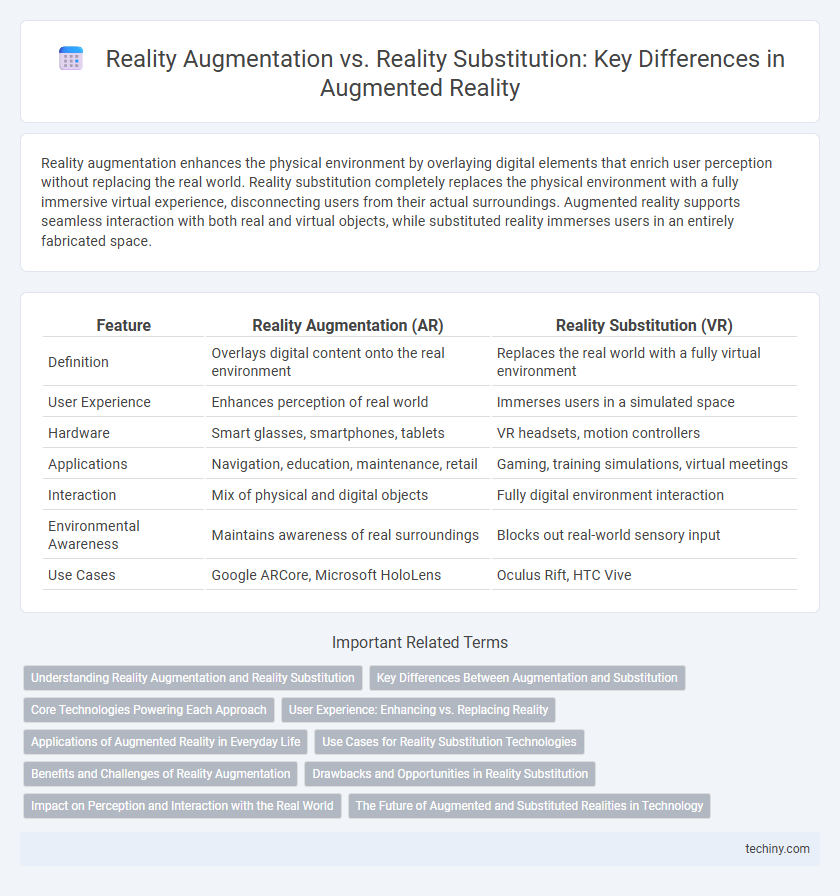Reality augmentation enhances the physical environment by overlaying digital elements that enrich user perception without replacing the real world. Reality substitution completely replaces the physical environment with a fully immersive virtual experience, disconnecting users from their actual surroundings. Augmented reality supports seamless interaction with both real and virtual objects, while substituted reality immerses users in an entirely fabricated space.
Table of Comparison
| Feature | Reality Augmentation (AR) | Reality Substitution (VR) |
|---|---|---|
| Definition | Overlays digital content onto the real environment | Replaces the real world with a fully virtual environment |
| User Experience | Enhances perception of real world | Immerses users in a simulated space |
| Hardware | Smart glasses, smartphones, tablets | VR headsets, motion controllers |
| Applications | Navigation, education, maintenance, retail | Gaming, training simulations, virtual meetings |
| Interaction | Mix of physical and digital objects | Fully digital environment interaction |
| Environmental Awareness | Maintains awareness of real surroundings | Blocks out real-world sensory input |
| Use Cases | Google ARCore, Microsoft HoloLens | Oculus Rift, HTC Vive |
Understanding Reality Augmentation and Reality Substitution
Reality augmentation overlays digital information onto the physical environment, enhancing user perception by blending virtual elements with real-world views. Reality substitution replaces the physical environment entirely with a computer-generated setting, immersing users in a fully virtual experience often seen in virtual reality systems. Understanding these distinctions is essential for developing applications that leverage spatial computing to either enhance or replace real-world interactions.
Key Differences Between Augmentation and Substitution
Reality augmentation enhances the existing environment by overlaying digital information onto the physical world, preserving user awareness of real-world surroundings. In contrast, reality substitution completely replaces the real environment with a fully immersive virtual experience, isolating users from their physical context. Key differences include user perception continuity, technological complexity, and use cases where augmentation supports interaction with reality while substitution enables immersive simulations.
Core Technologies Powering Each Approach
Reality augmentation relies on advanced sensors, computer vision algorithms, and real-time data processing to overlay digital information onto the physical environment, enhancing user perception without altering the actual surroundings. Core technologies include spatial mapping, depth sensing, and SLAM (Simultaneous Localization and Mapping) to accurately integrate virtual objects within the real world. In contrast, reality substitution employs immersive displays like VR headsets along with motion tracking and environmental modeling to completely replace the user's sensory input with a fully simulated environment.
User Experience: Enhancing vs. Replacing Reality
Reality augmentation enhances user experience by overlaying digital information onto the physical environment, allowing users to interact with both real and virtual elements simultaneously. Reality substitution, in contrast, replaces the physical world entirely with a virtual environment, immersing users but potentially reducing awareness of real surroundings. Augmented reality improves situational awareness and usability by blending real-world context with supplementary data, while virtual reality prioritizes immersive experiences through complete environmental replacement.
Applications of Augmented Reality in Everyday Life
Augmented Reality (AR) enhances the real world by overlaying digital information, enabling applications such as navigation assistance, interactive education, and virtual try-on experiences in retail. Reality substitution, often seen in Virtual Reality (VR), replaces the physical environment entirely, making it less suitable for everyday tasks that require real-world interaction. AR's ability to blend virtual elements with reality supports seamless integration in daily activities, improving productivity, entertainment, and learning outcomes.
Use Cases for Reality Substitution Technologies
Reality substitution technologies replace the user's perception of the real world with a fully immersive virtual environment, enabling applications such as virtual training simulations, remote collaboration in hazardous environments, and therapeutic interventions for phobias or PTSD. These use cases leverage the ability to control and manipulate entire sensory inputs, providing safe, customizable, and repeatable scenarios that enhance learning and rehabilitation outcomes. Industries like aerospace, healthcare, and defense increasingly adopt reality substitution to simulate complex, high-risk situations without physical exposure.
Benefits and Challenges of Reality Augmentation
Reality augmentation enhances the real world by overlaying digital information, improving user interaction without completely obscuring physical surroundings. Benefits include increased situational awareness, seamless integration with the environment, and real-time data access that supports decision-making in fields like healthcare, education, and manufacturing. Challenges involve ensuring accurate spatial mapping, minimizing latency, and addressing privacy concerns related to continuous data collection and user monitoring.
Drawbacks and Opportunities in Reality Substitution
Reality substitution, which replaces the user's physical environment entirely with a virtual one, can lead to disorientation and reduced situational awareness, posing significant safety risks in dynamic real-world settings. Opportunities in reality substitution include immersive training simulations and remote collaboration, where full environmental control enhances focus and interaction without physical constraints. However, challenges such as user isolation and higher hardware demands must be addressed to enable widespread adoption across industries like healthcare, education, and entertainment.
Impact on Perception and Interaction with the Real World
Reality augmentation enhances user perception by overlaying digital elements onto the physical environment, allowing seamless interaction without obstructing real-world views. Reality substitution replaces the user's natural environment entirely with a virtual setting, which can disrupt spatial awareness and diminish direct sensory connection to the physical world. This fundamental difference affects cognitive processing and user engagement, with augmentation supporting contextual awareness and substitution enabling immersive experiences disconnected from immediate reality.
The Future of Augmented and Substituted Realities in Technology
Reality augmentation enhances the physical environment by overlaying digital information, enabling seamless interaction between users and real-world objects. Reality substitution replaces the physical environment entirely with a virtual experience, as seen in immersive virtual reality applications. Advancements in sensor technology, AI, and display systems are driving the convergence of augmented and substituted realities, shaping a future where mixed reality ecosystems transform industries such as healthcare, education, and entertainment.
reality augmentation vs reality substitution Infographic

 techiny.com
techiny.com